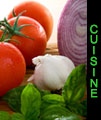Major Red Grapes
There are over twenty major types of red grape varieties in Italy, but we can start with what are arguably the most important three:
Sangiovese (san joe VAE sae) - Planted in plenty throughout the country, particularly in Tuscany and Umbria, this is the major grape of Chianti and the popular Super-Tuscan wines. Medium in body, the grape typically carries strong tannin, high acidity and flavors of herbs and cherries.
Nebbiolo(nehb be OH loh) - Specific to the Piedmont region, this grape makes two of Italy's most notorious wines: Barolo and Barbaresco. These wines are a shoe-in for anyone building a cellar because they age particularly well. The grape is full-bodied with high acidity and strong tannin, invoking flavors of strawberries, mushrooms, tar and truffles.
Barbera (bar BAE rah) - This grape runs neck and neck with Sangiovese as the most planted in the country. It is a lighter grape with little tannin and high acidity. The fruit flavors tend to be more pronounced than in other varieties and as such it is an excellent summer red and great on its own.
Important Italian Whites
Pinot Grigio(pee noh GREE joe) - The Italian version of Pinot Gris, this white grape has won widespread acclaim all over the world. Though not as rich as its French counter-part, it carries flavors of peach with a high-acid, minerally quality.
Trebbiano (trehb bee AH noh) - Though undeniably common in Italy, it has also suffered from casual growing habits. It is primarily known for producing inexpensive whites that are crisp and bland. It is a wine that at best pairs well with food, particularly shell-fish, and rarely can be enjoyed on its own.
Tocai Friulano (toh KYE free oo LAH no) - Fans of Pinot Grigio tend to be pleasantly surprised by this grape. With characteristic Italian crispness and acidity, it can also carry rich and full textures that are more complex than is typical for whites. It grows primarily in the Friuli region.
Verdicchio and Vernaccia - These grapes have some of the same body, crispness and acidity as Trebbino, but with a bit more spunk. Richer flavors and aromas including hints of lemon and sea air are common. They are typically un-oaked.
One could spend a lifetime learning all there is to know about the dozens of grape varieties grown in Italy, particularly when you explore how they are best paired with foods from their respective regions. Further articles will explore some of the rules governing wine production in Italy, including how to sift your way through wine labels, but having a familiarity with the major grapes listed above will form a firm foundation for discovering the distinctive personalities of Italian wine!
YourGuidetoItaly.com 2005-2009 © All Rights Reserved.
Photos of the YourGuidetoItaly.com banner (from left to right): (on campus) Sean Locke, (red deckchair) Valentina Jori, (chianti botlle) Donald Gruener, (Vitruvian man) Jodie Coston, (coliseum), Roberto A Sanchez, (Fiat 500) Luca di Filippo.
.
.
.












